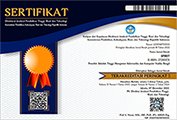BERBANTUAN YOUTUBE SEBAGAI MEDIA PEMBELAJARAN DAN METODE TUTOR SEBAYA (PEER TUTORING) UNTUK MENINGKATKAN PRESTASI BELAJAR KOMPOSISI FOTO DAN VIDEO (TYPE OF SHOT)
Abstract
Abstract: The purpose of this study was to improve the Learning Achievement of Photo and Video Composition (Type of Shot) students of class XI Production and Broadcast Television Program (PSPT) SMK Negeri 1 Bangil, peer tutoring learning methods and assisted by YouTube as a learning medium with 32 students as the
subject. .
This research is a classroom action research conducted in two cycles with the stages (1) initial design, (2) observation, (3) reflection, and (4) revised design. Based on the research that has been done, it can be concluded that there is an increase in learning achievement of the Composition of Photos and Videos (Type of Shot) with peer tutoring and assisted by YouTube as a learning medium, namely in cycle I with an average of 68.91 and students. 22 students (68.76%) experienced mastery learning with a value> 70. Whereas in cycle II with an average of 82.97 and students who complete learning as many as 28 students (87.50%), thus the peer tutoring method and assisted by YouTube as a learning medium can improve the learning achievement of Photo and Video Composition ( Type of Shot) students of class XI Production and Broadcast Television Program (PSPT) SMK Negeri 1 Bangil and can be used in other schools on different subjects.
Â
Keywords: Youtube, Peer Tutoring, Photo and Video Composition ( Type of Shot)
Full Text:
PDF (Bahasa Indonesia)References
Abdurrahman, M. (2003). Pendidikan Bagi Anak
Berkesulitan Belajar. Jakarta : Rineka Cipta.
Ahmadi, A., dan Supriyono, W. (2004). Psikologi
Belajar. Jakarta: Rineka Cipta.
Arjanggi, R dan Suprihatin, T. (2010). Metode
Pembelajaran Tutor Sebaya Meningkatkan Hasil
Belajar Berdasar Regulasi Diri. Makara Sosial
Humaniora
Arikunto, S. (2007). Penelitian Tindakan Kelas.
Jakarta: Bumi Aksara
Burke, S.C., Snyder, S., Rager, R.C. (2009). An
Assessment of Faculty Usage of YouTube as a
Teaching Resource. The Internet Journal of
Allied Health Sciences and Practice. 7(1).
diperoleh dari http://ijahsp.nova.edu
Carpenter, S. K., & Toftness, A.R. (2017). The
Effect of Prequestions on Learning from Video
Presentations. Journal of Applied Research in
Memory and Cognition, 6 (1), 104–109.
https://doi.org/10.1016/j.jarmac.2016.07.014
Dimyati, Mudjiono, (2006). Belajar dan
Pembelajaran. Jakarta: PT. Rineka Cipta
Djamarah, S.B. dan Zain, Aswan. (2006).
Belajar Mengajar. Jakarta: Rineka Cipta
Furi, U. L., & Mustaji, Nf. (2017).
Pengembangan Media Video Mata Pelajaran
Komposisi Foto Digital Bagi Siswa Kelas XI
Multimedia di Sekolah Menengah Kejuruan.
Jurnal Kwangsan, vol.5 No.2, hal. 91-100.
DOI:
https://doi.org/10.31800/jtp.kw.v5n2.p91-100
Ischak, Warji. (1987). Program Remedial dalam
Proses Belajar Mengajar. Yogyakarta: Liberty
Jossberger, H., Brand-Gruwel, S., van
de Wiel, M. W. J., & Boshuizen, H. (2017).
Learning in Workplace Simulations in
Vocational Education: a Student Perspective.
Vocations and Learning.
https://doi.org/10.1007/s12186-017-9186-7
Lestari, Sri. (2015) Faktor-faktor yang
Mempengaruhi Pemanfaatan Teknologi
Informasi dan Komunikasi oleh Guru.
Jurnal Kwangsan, Vol. 3 No. 2, hal. 121-
DO: https://
doi.org/10.31800/jtp.kw.v3n2.p121—134
Makarao, N. Ramadhani. (2009). Metode
Mengajar dalam Bidang Kesehatan. Bandung:
Alfabeta
Maulana, A , dkk (2019). Pengembangan
Media Video Presentasi Pada Mata Kuliah
Hidrologi di Universitas Negeri Jakarta.
Jurna Kwangsan, Vol. 7 No. 2. Hal. 170-
DOI:
https://doi.org/10.31800/jtp.kw.v7n2.p170
--183
Mukhlis, Abdul (Ed), (2000), Penelitian
Tindakan Kelas, Makalah Panitia Penulisan
Karya Ilmiah untuk Guru-guru seKabupaten Tuban.
Mustafa, Z. (2019). Pengaruh Discovery
Learning Berbantuan e-Learning dalam
Meningkatkan Penguasaan Konsep Siswa
tentang Konsentrasi Larutan dan
Aplikasinya, Jurnal Kwangsan, Vol. 7 No. 1
hal. 14—29,
DOI:https://doi.org/10.31800/jtp.kw.v7n1.p14
— Ngalim P. (2006). Prinsip-Prinsip dan
Teknik Evaluasi Pengajaran, Bandung: Remaja
Rosdakarya
Prastiyo, W., Djohar, A., & Purnawan, P.
(2018). Development of Youtube integrated
google classroom based e-learning media for
the light-weight vehicle engineering
vocational high school. Jurnal Pendidikan
Vokasi, 8 (1), 53.
https://doi.org/10.21831/jpv.v8i1.17356
Purnomo, Y.W. (2011). Keefektifan Model
Penemuan Terbimbing Dan Cooperative
Learning Pada Pembelajaran Matematika.
Jurnal Pendidikan, vol.41, No.1.
journal.uny.ac.id
Pusat Pembinaan dan Pengembangan
Bahasa. (1995). Kamus Besar Bahasa
Indonesia (KBBI). Jakarta: Balai Pustaka.
Revans, Reg. (1998). Action Learning. New
York: Hart Publishing Co.
Ristasa, R.A. (2003) Pedoman
Penyususunan Proposal dan Penulisan
Laporan Penelitian Tindakan Kelas.
Purwokerto: Kementerian Pendidikan
dan Kebudayaan Universitas Terbuka
Rivalina, R.(2017). Strategi Pemanfaatan elearning Dalam Mengatasi Keterbatasan
Jumlah Dosen. Jurnal Kwangsan, Vol.5
No. 2, hal. 129–145. DOI :
https://doi.org/10.31800/jtp.kw.v5n2.p129-
-145
Rusman. (2016). Pengembangan Model eLearning untuk Meningkatkan Hasil Belajar
Mahasiswa. Jurnal Kwangsan, Vol. 4
No.1, hal. 1–15. DOI :
https://doi.org/10.31800/jtp.kw.v4n1.p1--
Satriyaningsih. (2009). Efektivitas Metode
Pembelajaran Tutor Sebaya untuk
Meningkatkan Hasil Belajar Biologi pada
Pokok Bahasan Ekosistem pada Siswa Kelas
VII SMP Bhinneka Karya Klego Boyolali
Tahun Ajaran 2008/2009. Skripsi.
Surakarta: Universitas Muhammadiyah
Surakarta
Shofifah, A. (2013). Pengembangan Media
Kartu Hidrologi untuk Mata Pelajaran
Geografi pada Pokok Bahasan Hidrosfer dan
Dampaknya terhadap Kehidupan di Muka
Bumi di Kelas X SMA Negeri 1 Driyorejo
Gresik. Jurnal Swara Bhumi, 2(3), 195–
https://doi.org/10.1192/bjp.112.483.211-a
Smaldino, S. E., Lowther, D. L., &
Russell, J. D. (2012). Instructional
Technology & Media For Learning (9th
ed.). Jakarta: Kencana Prenada Media
Group
Sudjana, N. (2006), Penilaian Hasil Proses
Belajar Mengajar, Remaja Rosda Karya
Thoma, M., & Ostendorf, A. (2017).
Discourse Analysis as a Tool for Promoting
the ‘Critical Literate’ VET Teacher.
Vocations and Learning, 11 (2), 1–19.
https://doi.org/10.1007/s12186-017-9188-5
Tohari, H. Mustaji & Bachtiar S.B, (2019)
Pengaruh Penggunaan Youtube Terhadap
Motivasi Belajar dan Hasil Belajar
Mahasiswa. Jurnal Kwangsan, Vol. 7 No.
hal. 1-13.
DOI: https://doi.org/10.31800/jtp.kw.v7n1
.p1--13
Utomo, S.W., Liana V.W. (2019).
Penerapan Strategi Blended Learning untuk
Meningkatkan Kemampuan Berpikir
Kritis Mahasiswa pada Era Revolusi
Industri 4.0. Jurnal Kwangsan Vol 7 No.
hal. 30-44.
DO:https://doi.org/10.31800/jtp.kw.v7n1,
p30--44
Winataputra, U.S. (1999). Pendekatan
Pembelajaran Kelas Rangkap. Jakarta:
Departemen Pendidikan dan
Kebudayaan.
-----------, (2005). Strategi Belajar Mengajar.
Jakarta : Depdikbud.
DOI: http://dx.doi.org/10.53567/spirit.v13i1.200
Refbacks
- There are currently no refbacks.
Copyright (c) 2021 Jurnal SPIRIT
Diindeks Oleh:
SPIRIT : Sarana Penunjang Informasi Terkini
Diterbitkan oleh Teknologi Informasi Institut Teknologi dan Bisnis Yadika Pasuruan
Alamat Redaksi: Jl. Bader No.9, Kwangsan, Kalirejo, Kec. Bangil, Pasuruan, Jawa Timur 67153
Telp/Fax: (0343) 742070 , Email : lppm@stmik-yadika.ac.id
Google Maps : Klik Disini

Karya ini dilisensikan di bawah Lisensi Internasional Creative Commons Atribusi 4.0 .







1.png)







